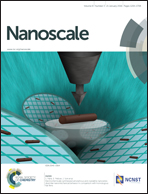Nanofocusing beyond the near-field diffraction limit via plasmonic Fano resonance†
Abstract
The past decade has witnessed a great deal of optical systems designed for exceeding the Abbe's diffraction limit. Unfortunately, a deep subwavelength spot is obtained at the price of extremely short focal length, which is indeed a near-field diffraction limit that could rarely go beyond in the nanofocusing device. One method to mitigate such a problem is to set up a rapid oscillatory electromagnetic field that converges at the prescribed focus. However, abrupt modulation of phase and amplitude within a small fraction of a wavelength seems to be the main obstacle in the visible regime, aggravated by loss and plasmonic features that come into function. In this paper, we propose a periodically repeated ring-disk complementary structure to break the near-field diffraction limit via plasmonic Fano resonance, originating from the interference between the complex hybrid plasmon resonance and the continuum of propagating waves through the silver film. This plasmonic Fano resonance introduces a π phase jump in the adjacent channels and amplitude modulation to achieve radiationless electromagnetic interference. As a result, deep subwavelength spots as small as 0.0045λ2 at 36 nm above the silver film have been numerically demonstrated. This plate holds promise for nanolithography, subdiffraction imaging and microscopy.


 Please wait while we load your content...
Please wait while we load your content...